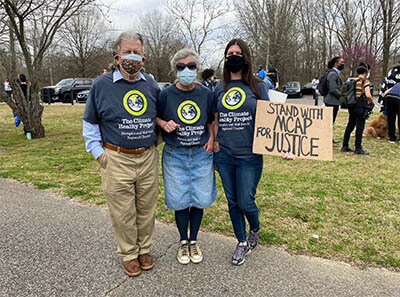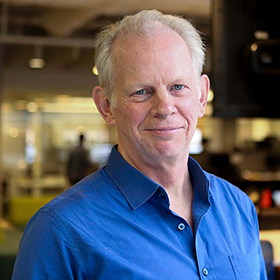All throughout the COVID-19 pandemic’s reign, with the unfathomable loss of life as well as the grinding struggle to battle back racism and advance equity, front-line nonprofits have had to reorient and respond to the extraordinary suffering across their communities, even as others confronted such existential threats as climate change. But what of the nonprofits themselves? How can they summon the resilience to serve so many in such deep need, when the world around them is so unstable and often unknowable?
When a crisis sets in and fear looms large, it can hobble people’s confidence and chip away at their sense of agency. However, any nonprofit that is making progress against its goals possesses an inner superpower—that special something that makes the organization what it is and enables it to achieve its maximum impact. A superpower could be a resource or a capability, a mindset or an approach. Whatever form it might take, a superpower animates a nonprofit. It helps the nonprofit stand out among its peers. And it’s a force for multiplying impact, enabling the nonprofit to achieve the most that it can for those whom it serves.
This article is the second in a three-part series highlighting strategies for strengthening nonprofits so that they are better prepared to push through the current crisis—and the challenges to come. Learn more about the series in the introduction, “How to Build Nonprofit Resilience.”
A superpower is fully expressed through an organization’s programs, services, or culture. Perhaps the nonprofit excels at bringing groups with different agendas together, such as community members, business leaders, and government officials. Or it’s renowned for harnessing technical expertise.
By putting these unique assets to work, organizations increase the odds that they will not only endure adversity, they might also discover new opportunities to advance, despite all the obstacles. In fact, marshalling those critical assets that comprise a superpower is vital even in the absence of a crisis, given that it is incumbent on nonprofits to adapt as the world around them changes.
Defining a Superpower
So what specifically is a superpower? Consider a young nonprofit named ImmSchools. Co-founded in 2018 by three formerly undocumented women who migrated to the United States as children, ImmSchools partners with K-12 schools to create safe and supportive learning environments for undocumented students.
ImmSchools’ superpower is the empathy the organization and its leaders have for their clients. The superpower consists of the nonprofit’s capacity to deeply identify with the struggles, breakthroughs, and life experiences of undocumented young people and their families. “We are a 100 percent, immigrant-led organization,” said ImmSchools’ co-founder and CEO, Viridiana Carrizales. “It is the foundation of what we are as an organization.” That fact has helped ImmSchools build an unshakeable bond of trust with its clients, intuit their needs, and quickly respond to the community’s challenges.

ImmSchools' leadership team: Co-founder and Chief
Strategy Officer Lorena Tule-Romain (left), Co-founder and
Chief Program Officer Vanessa Luna (center), and Co-founder,
CEO, and Board President Viridiana Carrizales (right).
(Photo Credit: ImmSchools)
ImmSchools’ co-founders—who also include Chief Program Officer Vanessa Luna and Chief Strategy Officer Lorena Tule-Romain—endured many of the same searing experiences as their clients, including the gnawing worry that they could be swept up by ICE or lose a family member to deportation. Carrizales recalled that at age 16, she confessed to her high school guidance counsellor that she was undocumented and lacked a social security card. The counselor immediately called ICE on her.
At the same time, Carrizales, Luna, and Tule-Romain also frequently witnessed the strength and courage of parents in their community—their determination to work through the pain of leaving their home countries and their success in building entrepreneurial lives in this country. They saw community members advocate for their children’s education and tap into their own power when, for example, exercising their rights during a traffic stop.
These experiences, both painful and inspirational, have shaped the way the co-founders approach their work at ImmSchools every day. “Growing up undocumented in this country has built resiliency in ourselves,” said Carrizales. “We are now using some of those same strategies as an organization, to make sure we can not only survive this crisis, but come out of it even stronger.”
Growing up undocumented in this country has built resiliency in ourselves. We are now using some of those same strategies as an organization, to make sure we can not only survive this crisis, but come out of it even stronger.
A crisis often clarifies a superpower, which was certainly true of ImmSchools during the spring of 2020. Back then, as the COVID-19 pandemic shuttered schools and forced businesses to lock down, the pain was especially acute across the roughly 11 million undocumented residents in the United States. Many worked in child care and other jobs that the coronavirus obliterated, since families had to self-isolate to safeguard their health. And yet, when federal lawmakers responded to the economy’s downward spiral with a $2 trillion stimulus package, the relief excluded millions of undocumented immigrants who lacked Social Security numbers but still paid federal taxes.
With job losses mounting across these communities and families struggling to pay for food, housing, and other life essentials, ImmSchools’ leaders recognized that they had a responsibility to support families and students in their programs against the pandemic’s predations. But they were educators, not relief workers.
However, ImmSchools’ superpower—its deep empathy—allowed its leaders to develop a community-informed solution that the organization had not previously tried: a relief fund for families.
Within a matter of weeks, ImmSchools raised $200,000, creating an emergency response fund that provided direct financial assistance to imperiled families—something the co-founders had discussed previously, but they had never moved from contemplation to action. The pandemic’s devastation made it an urgent imperative: ImmSchools had to tap into its superpower, its core value of empathy, to go beyond the organization’s perceived limitations and provide for its community in a time of great need.
“This is the very essence of what it means to be an immigrant,” said Carrizales. “We create and build even in instances when nothing seems possible.”
Carrizales and the ImmSchools’ team nurtured empathy for their clients, not only because of their deep personal experience, but also through a commitment to hear, understand, and stand shoulder to shoulder with students and families in their community. Empathy, like most other nonprofit superpowers, is not a fixed trait. It is built over time, brick by brick.
Putting a Superpower to Work
The pressures of a crisis can push a nonprofit to clarify its superpower. Once defined, a superpower helps propel a nonprofit into the future—and stand a better chance of surmounting whatever obstacles might arise. That’s because the very act of planning for the future and mapping the next steps for achieving it is another critical part of building organizational resilience.
As we outlined in the article, “To Combat Adversity, Resilient Nonprofits Think Long and Short,” nonprofits bring their sense of agency to life when they give themselves the space to “think long.” That is, they set their sights on a bold, 10-year vision of how they might dramatically advance their impact. They then tighten their focus and “think short,” by mapping out what they need to accomplish over the next 12 to 18 months, so they can take a big first step toward realizing their loftiest ambition. They do that by harnessing their superpower, the catalyst that helps them achieve their short-term goals and long-term vision.
What does it look like when a nonprofit channels its superpower toward catalytic impact?
One answer can be found in the experiences of The Climate Reality Project. Led by former US Vice President Al Gore, and CEO and President Ken Berlin, Climate Reality’s bold ambition is to spur actions that dramatically cut greenhouse gas emissions by as much as 60 percent by 2030 and ultimately help free the planet from the chokehold of fossil fuels.

Climate Reality Project members attend a Memphis
Community Against the Pipeline rally.
(Photo Credit: Leo Arnoult)
Climate Reality’s superpower consists of its ability to reimagine design solutions for surmounting big challenges. The organization’s design solution for climate change was to help mobilize a mass movement of climate activists. Over the years, Climate Reality designed an ongoing series of three-day, in-person events that brought hundreds of activists together. The organization’s workshops equipped attendees with the tools, knowledge, and networks to return to their communities and organize the fight for a just and equitable clean economy. By the end of 2020, the nonprofit had enlisted more than 31,000 “Climate Reality Leaders” in the globe-spanning effort to combat climate change.
However, 2020 was no ordinary year for adding more activists to Climate Reality’s ranks. Climate Reality had planned on-the-ground trainings in five US cities, with approximately 1,500 people attending each. But that spring, with the pandemic’s remorseless reach making large-scale, in-person gatherings potential super-spreader events, change was forced upon the organization. Climate Reality had to figure out how to deliver its workshops virtually, within a matter of weeks. “Suddenly, our people had to work very, very hard on something completely new,” Berlin recalled. “Everything required rethinking.”
Suddenly, our people had to work very, very hard on something completely new. Everything required rethinking.
The shift meant that Climate Reality had to stretch a three-day event across a week-long virtual training, so people could absorb the learnings in a Zoom environment. It meant cataloging all the myriad details that comprise a large event and recasting them in Zoom, in a way that would still keep attendees engaged. It meant that once one mass virtual event was completed, the staff had to debrief, regroup, and immediately innovate on the next one, even as they dealt with COVID-19’s impact on their personal lives and the lives of family members.
“It was six months of just full-force effort,” recalled Vanessa LaVallee, the nonprofit’s senior vice president for Operations and Advancement.
Climate Reality achieved all of that by harnessing its superpower—its agile approach to program design. Over the years, its staff learned not only to rapidly prototype, but also to work seamlessly together. Although the organization had other choices when the pandemic hit, such as cancelling its live events or dramatically scaling them back (which in the heat of the moment, might have seemed like the best option), the nonprofit’s superpower enabled it to put all its design skills to bear and pivot to an option that was as outsized as it was untested.
Want to put the advice from this article into practice? Download the "Conversation Starter: How to Put Your Organization's Superpower to Work" to get started. The questions included in the tool can help your leadership team surface and use the special assets your nonprofit has to advance its impact.
Download the conversation starter >>
By leaning into designing an all-virtual program, Climate Reality dramatically shifted from the way it had worked to the way it probably should. By the fall of 2020, the nonprofit succeeded in virtually training 9,700 grassroots activists, significantly more than it originally planned for. By proving it can train more people virtually and also reap climate benefits, “it’s put us in a whole new environment for how we do this work,” said LaVallee. “Now we’ve got to figure out, how do we as an organization expand fast enough?”
Regardless of how Climate Reality answers that question, it has already demonstrated that despite the pandemic’s constraints, the nonprofit’s superpower has enabled it to accomplish far more than it previously imagined, and thereby take a big step toward its 10-year goal. In this way, the organization underlined a core feature of organizational resilience: the capacity to not only work through difficult challenges, but also embrace change and improve along the way.
“We often say that change takes much longer to happen than you think it will,” said Berlin. “And then it happens faster than you thought it would.”
Some Takeaways
So what can we learn from ImmSchools, the Climate Reality Project, and other nonprofits that have sought to make themselves resilient by harnessing their superpowers?
Start by defining. A superpower might sometimes be hard to pin down. It is not necessarily your blue-chip programs, the star-power of your CEO, or the sheen of your brand. So before you attempt to tap into it, first agree on what it is. What’s the DNA that enables your organization—and all of your staff—to play a catalytic role in achieving your long-term vision? What would entice stakeholders to come to your organization versus another? What do people rave about when they recount what you helped them accomplish? Answering those questions will help you surface the deeper knowledge and capabilities that make your nonprofit distinctly impactful in the world.
Use your superpower to pressure test your organization’s long-term vision. A core strategy for building resilience is to identify a bold, 10-year vision for your nonprofit. A vision that marks a point on the horizon to navigate to; a vision that inspires contributions from everyone. Having defined your superpower, you can now use it to test whether you’re headed in the right direction. Ask whether your organization’s unique assets can really help you land your organization in that unfolding future. If there is any doubt, take some time to reorient toward a vision that aligns with your unique capabilities.
Aim your superpower toward your organization’s ultimate destination. Once clear on what makes your organization uniquely impactful, step back and think about how to use those assets to propel you toward your long-term destination. This is an opportunity to untether yourselves from your day-to-day work and unpack exactly how your superpower can get you from where you are to where you need to go. What does that unleash for your team? If you fully utilized your superpower, what new opportunities would open up—for example, opportunities to innovate on existing programs or craft new approaches or ways of working?
One final thought: If your team wants to dig deeper into defining and harnessing your superpower, you can download the brief primer for starting that conversation: "How to Put Your Organization's Superpower to Work."
Meera Chary, a partner in Bridgespan’s San Francisco office, co-leads (with Bridgespan Partner Preeta Nayak and Bridgespan Principal Colleen Brosman) the Nonprofit Resiliency Initiative, in collaboration with the Emerson Collective. Bridgespan Editorial Director Bill Breen is based in Boston.



